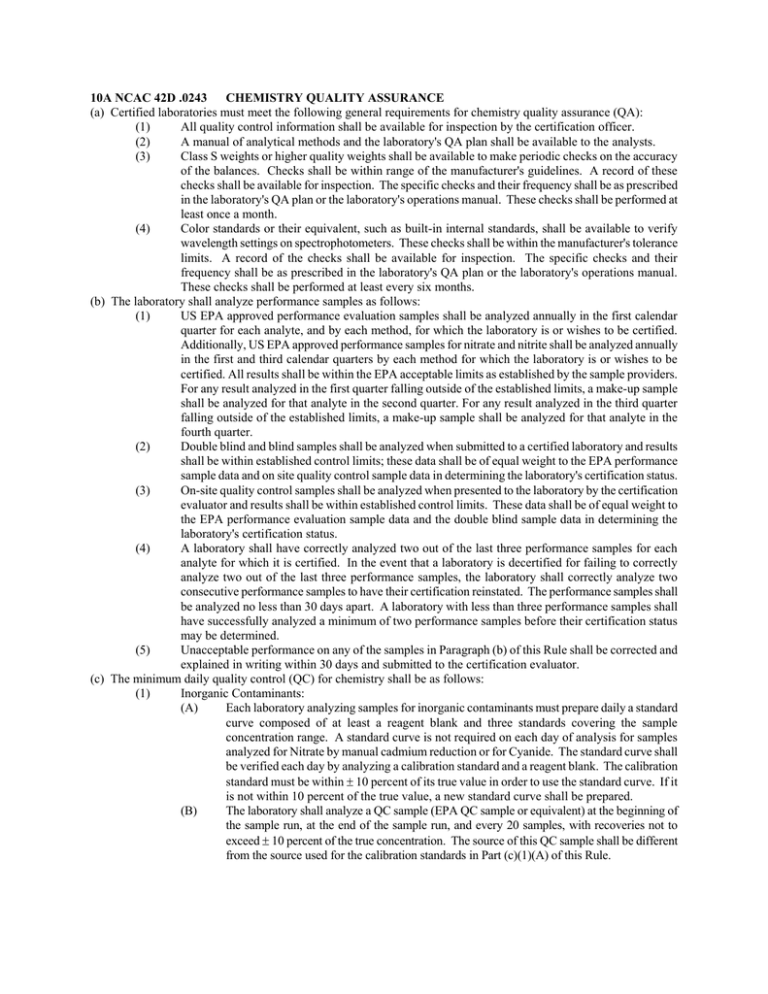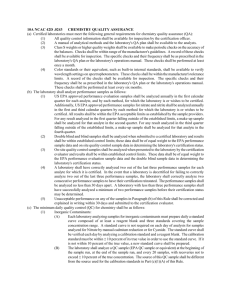10A NCAC 42D .0243 CHEMISTRY QUALITY ASSURANCE (a
advertisement

10A NCAC 42D .0243 CHEMISTRY QUALITY ASSURANCE (a) Certified laboratories must meet the following general requirements for chemistry quality assurance (QA): (1) All quality control information shall be available for inspection by the certification officer. (2) A manual of analytical methods and the laboratory's QA plan shall be available to the analysts. (3) Class S weights or higher quality weights shall be available to make periodic checks on the accuracy of the balances. Checks shall be within range of the manufacturer's guidelines. A record of these checks shall be available for inspection. The specific checks and their frequency shall be as prescribed in the laboratory's QA plan or the laboratory's operations manual. These checks shall be performed at least once a month. (4) Color standards or their equivalent, such as built-in internal standards, shall be available to verify wavelength settings on spectrophotometers. These checks shall be within the manufacturer's tolerance limits. A record of the checks shall be available for inspection. The specific checks and their frequency shall be as prescribed in the laboratory's QA plan or the laboratory's operations manual. These checks shall be performed at least every six months. (b) The laboratory shall analyze performance samples as follows: (1) US EPA approved performance evaluation samples shall be analyzed annually in the first calendar quarter for each analyte, and by each method, for which the laboratory is or wishes to be certified. Additionally, US EPA approved performance samples for nitrate and nitrite shall be analyzed annually in the first and third calendar quarters by each method for which the laboratory is or wishes to be certified. All results shall be within the EPA acceptable limits as established by the sample providers. For any result analyzed in the first quarter falling outside of the established limits, a make-up sample shall be analyzed for that analyte in the second quarter. For any result analyzed in the third quarter falling outside of the established limits, a make-up sample shall be analyzed for that analyte in the fourth quarter. (2) Double blind and blind samples shall be analyzed when submitted to a certified laboratory and results shall be within established control limits; these data shall be of equal weight to the EPA performance sample data and on site quality control sample data in determining the laboratory's certification status. (3) On-site quality control samples shall be analyzed when presented to the laboratory by the certification evaluator and results shall be within established control limits. These data shall be of equal weight to the EPA performance evaluation sample data and the double blind sample data in determining the laboratory's certification status. (4) A laboratory shall have correctly analyzed two out of the last three performance samples for each analyte for which it is certified. In the event that a laboratory is decertified for failing to correctly analyze two out of the last three performance samples, the laboratory shall correctly analyze two consecutive performance samples to have their certification reinstated. The performance samples shall be analyzed no less than 30 days apart. A laboratory with less than three performance samples shall have successfully analyzed a minimum of two performance samples before their certification status may be determined. (5) Unacceptable performance on any of the samples in Paragraph (b) of this Rule shall be corrected and explained in writing within 30 days and submitted to the certification evaluator. (c) The minimum daily quality control (QC) for chemistry shall be as follows: (1) Inorganic Contaminants: (A) Each laboratory analyzing samples for inorganic contaminants must prepare daily a standard curve composed of at least a reagent blank and three standards covering the sample concentration range. A standard curve is not required on each day of analysis for samples analyzed for Nitrate by manual cadmium reduction or for Cyanide. The standard curve shall be verified each day by analyzing a calibration standard and a reagent blank. The calibration standard must be within 10 percent of its true value in order to use the standard curve. If it is not within 10 percent of the true value, a new standard curve shall be prepared. (B) The laboratory shall analyze a QC sample (EPA QC sample or equivalent) at the beginning of the sample run, at the end of the sample run, and every 20 samples, with recoveries not to exceed 10 percent of the true concentration. The source of this QC sample shall be different from the source used for the calibration standards in Part (c)(1)(A) of this Rule. (C) (2) History Note: The laboratory shall run an additional standard or QC check at the laboratory's lowest detectable limit for the particular analyte. The laboratory shall not report a value lower than the lowest standard or QC check analyzed. (D) The laboratory shall add a known spike to a minimum of 10 percent of the routine samples (except when the method specifies a different percentage, i.e. furnace methods) to determine if the entire analytical system is in control. The spike concentration shall not be less than the background concentration of the sample selected for spiking. The spike recoveries shall not exceed 10 percent of the true value. (E) All compliance samples analyzed by graphite furnace shall be spiked to determine absence of matrix interferences with recoveries within 10 percent of the true value of the spike concentration. (F) The laboratory shall run a duplicate sample every 10 samples with duplicate values within 10 percent of each other. (G) Precision and accuracy data may be computed from the analyses of check samples of known value used in each analytical procedure. This data shall be available for inspection by the laboratory evaluator. Organic Contaminants: (A) Quality control specified in the approved methods referenced in Rule .0241 of this Section shall be followed. (B) Analysis for regulated volatile organic chemicals under 15A NCAC 18C .1515 shall only be conducted by laboratories that have received conditional approval by EPA or the Department according to 40 C.F.R. 141.24(g)(10) and (11) which is hereby incorporated by reference including any subsequent amendments and editions. A copy is available for inspection at the Department of Health and Human Services, Division of Public Health, 306 North Wilmington Street, Raleigh, North Carolina. Copies of 40 C.F.R. 141-143 may be obtained by contacting the EPA Drinking Water Hotline at 800-426-4791 at no charge. (C) Analysis for unregulated volatile organic chemicals under 15A NCAC 18C .1516 shall only be conducted by laboratories approved under Part (c)(2)(B) of this Rule. In addition to the requirements of Part (c)(2)(B) of this Rule, each laboratory analyzing for EDB and DBCP shall achieve a method detection limit for EDB of 0.00001 mg/l and DBCP of 0.00002 mg/l, according to the procedures in Appendix B of 40 C.F.R. Part 136 which is hereby incorporated by reference including any subsequent amendments and editions. A copy may be obtained at no charge by contacting the Department of Health and Human Services, Division of Public Health, 306 North Wilmington Street, Raleigh, North Carolina. (D) The laboratory shall achieve the method detection limits as listed in 40 CFR 141.24(f)(18) according to the procedures in Appendix B of 40 CFR Part 136 which is hereby incorporated by reference including any subsequent amendments and editions. A copy may be obtained at no charge by contacting the Department of Health and Human Services, Division of Public Health, 306 North Wilmington Street, Raleigh, North Carolina. Authority G.S. 130A-315; Eff. December 1, 1991; Amended Eff. August 1, 1996; January 1, 1996; October 1, 1994; April 1, 1993; Temporary Amendment Eff. January 1, 2003; Amended Eff. August 1, 2004.

